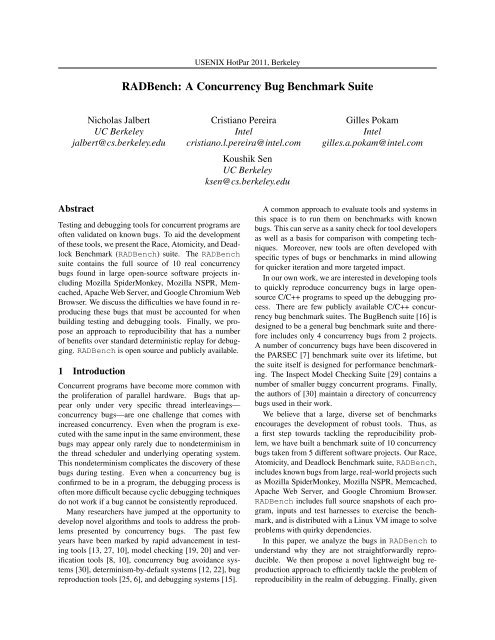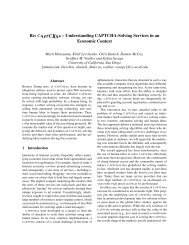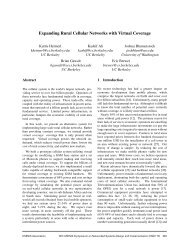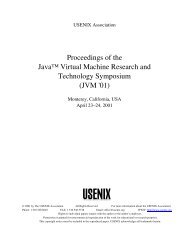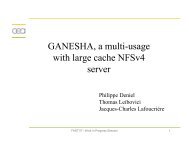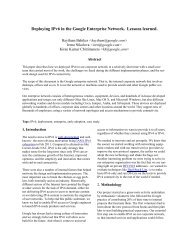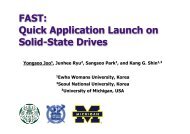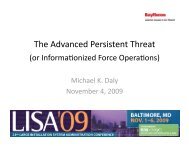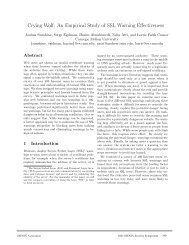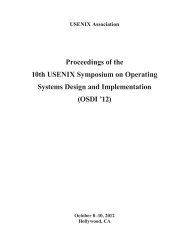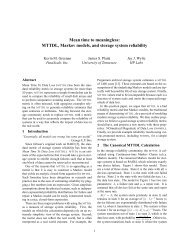RADBench: A Concurrency Bug Benchmark Suite - Usenix
RADBench: A Concurrency Bug Benchmark Suite - Usenix
RADBench: A Concurrency Bug Benchmark Suite - Usenix
You also want an ePaper? Increase the reach of your titles
YUMPU automatically turns print PDFs into web optimized ePapers that Google loves.
Nicholas Jalbert<br />
UC Berkeley<br />
jalbert@cs.berkeley.edu<br />
Abstract<br />
USENIX HotPar 2011, Berkeley<br />
<strong>RADBench</strong>: A <strong>Concurrency</strong> <strong>Bug</strong> <strong>Benchmark</strong> <strong>Suite</strong><br />
Testing and debugging tools for concurrent programs are<br />
often validated on known bugs. To aid the development<br />
of these tools, we present the Race, Atomicity, and Deadlock<br />
<strong>Benchmark</strong> (<strong>RADBench</strong>) suite. The <strong>RADBench</strong><br />
suite contains the full source of 10 real concurrency<br />
bugs found in large open-source software projects including<br />
Mozilla SpiderMonkey, Mozilla NSPR, Memcached,<br />
Apache Web Server, and Google Chromium Web<br />
Browser. We discuss the difficulties we have found in reproducing<br />
these bugs that must be accounted for when<br />
building testing and debugging tools. Finally, we propose<br />
an approach to reproducibility that has a number<br />
of benefits over standard deterministic replay for debugging.<br />
<strong>RADBench</strong> is open source and publicly available.<br />
1 Introduction<br />
Concurrent programs have become more common with<br />
the proliferation of parallel hardware. <strong>Bug</strong>s that appear<br />
only under very specific thread interleavings—<br />
concurrency bugs—are one challenge that comes with<br />
increased concurrency. Even when the program is executed<br />
with the same input in the same environment, these<br />
bugs may appear only rarely due to nondeterminism in<br />
the thread scheduler and underlying operating system.<br />
This nondeterminism complicates the discovery of these<br />
bugs during testing. Even when a concurrency bug is<br />
confirmed to be in a program, the debugging process is<br />
often more difficult because cyclic debugging techniques<br />
do not work if a bug cannot be consistently reproduced.<br />
Many researchers have jumped at the opportunity to<br />
develop novel algorithms and tools to address the problems<br />
presented by concurrency bugs. The past few<br />
years have been marked by rapid advancement in testing<br />
tools [13, 27, 10], model checking [19, 20] and verification<br />
tools [8, 10], concurrency bug avoidance systems<br />
[30], determinism-by-default systems [12, 22], bug<br />
reproduction tools [25, 6], and debugging systems [15].<br />
Cristiano Pereira<br />
Intel<br />
cristiano.l.pereira@intel.com<br />
Koushik Sen<br />
UC Berkeley<br />
ksen@cs.berkeley.edu<br />
Gilles Pokam<br />
Intel<br />
gilles.a.pokam@intel.com<br />
A common approach to evaluate tools and systems in<br />
this space is to run them on benchmarks with known<br />
bugs. This can serve as a sanity check for tool developers<br />
as well as a basis for comparison with competing techniques.<br />
Moreover, new tools are often developed with<br />
specific types of bugs or benchmarks in mind allowing<br />
for quicker iteration and more targeted impact.<br />
In our own work, we are interested in developing tools<br />
to quickly reproduce concurrency bugs in large opensource<br />
C/C++ programs to speed up the debugging process.<br />
There are few publicly available C/C++ concurrency<br />
bug benchmark suites. The <strong>Bug</strong>Bench suite [16] is<br />
designed to be a general bug benchmark suite and therefore<br />
includes only 4 concurrency bugs from 2 projects.<br />
A number of concurrency bugs have been discovered in<br />
the PARSEC [7] benchmark suite over its lifetime, but<br />
the suite itself is designed for performance benchmarking.<br />
The Inspect Model Checking <strong>Suite</strong> [29] contains a<br />
number of smaller buggy concurrent programs. Finally,<br />
the authors of [30] maintain a directory of concurrency<br />
bugs used in their work.<br />
We believe that a large, diverse set of benchmarks<br />
encourages the development of robust tools. Thus, as<br />
a first step towards tackling the reproducibility problem,<br />
we have built a benchmark suite of 10 concurrency<br />
bugs taken from 5 different software projects. Our Race,<br />
Atomicity, and Deadlock <strong>Benchmark</strong> suite, <strong>RADBench</strong>,<br />
includes known bugs from large, real-world projects such<br />
as Mozilla SpiderMonkey, Mozilla NSPR, Memcached,<br />
Apache Web Server, and Google Chromium Browser.<br />
<strong>RADBench</strong> includes full source snapshots of each program,<br />
inputs and test harnesses to exercise the benchmark,<br />
and is distributed with a Linux VM image to solve<br />
problems with quirky dependencies.<br />
In this paper, we analyze the bugs in <strong>RADBench</strong> to<br />
understand why they are not straightforwardly reproducible.<br />
We then propose a novel lightweight bug reproduction<br />
approach to efficiently tackle the problem of<br />
reproducibility in the realm of debugging. Finally, given
the benefits of having a common set of benchmarks the<br />
research community can draw upon, we are publicly releasing<br />
the <strong>RADBench</strong> benchmark suite so that other researchers<br />
can test tools and algorithms on these bugs.<br />
The rest of this paper is organized as follows. In Section<br />
2 we describe the programs and bugs included in<br />
<strong>RADBench</strong>. In Section 3, we describe the difficulties involved<br />
in finding, reproducing, and fixing these bugs. In<br />
Section 4, we propose a novel approach to the problem of<br />
reproducibility. In Section 5, we describe related work.<br />
Finally, we wrap up in Section 6.<br />
2 The <strong>RADBench</strong> <strong>Suite</strong><br />
The <strong>RADBench</strong> suite is composed of full source snapshots<br />
of large open-source software projects containing<br />
real concurrency bugs. Each bug in <strong>RADBench</strong> has a<br />
corresponding bug report in its respective project’s issue<br />
tracker. To assemble the <strong>RADBench</strong> suite, we searched<br />
each project’s bug database for bug reports that suggested<br />
a concurrency issue. When we found a promising<br />
report, we acquired a snapshot of the code base from before<br />
any fix was applied. We then ensured we could build<br />
and execute the program in a way that would expose the<br />
bug. Finally, we analyzed the root cause of the bug by<br />
studying developer comments and code changes.<br />
Table 1 describes the bugs included in <strong>RADBench</strong>.<br />
Column 1 (Program) is the name of the application<br />
containing the bug. <strong>RADBench</strong> includes bugs from<br />
Mozilla’s SpiderMonkey JavaScript engine, Mozilla’s<br />
Netscape Portable Runtime (NSPR), the Memcached<br />
distributed object caching system, Apache’s HTTP<br />
server, and Google’s Chromium Web Browser. Column<br />
2 (KLOC) shows size of each project in thousands<br />
of lines C/C++ code and headers. 1 Column 3<br />
(Issue Number) shows the identifier of the bug report<br />
that corresponds to the benchmark bug. Column 4<br />
(Manifestation) describes how the bug manifests.<br />
Finally, Column 5 (Time to Fix (days)) shows<br />
the time from the initial report until it was closed as fixed.<br />
The value n/a in this column means the report is open as<br />
of the time of writing.<br />
2.1 Mozilla SpiderMonkey<br />
Mozilla SpiderMonkey [3] is the C implementation of<br />
JavaScript that powers Mozilla’s Firefox browser. SpiderMonkey<br />
is released as a standalone product so other<br />
projects can embed JavaScript with minimal effort. SpiderMonkey<br />
exports an API that can be used by arbitrary<br />
C/C++ programs, and, when combined with NSPR,<br />
can be built in a threadsafe manner. Concurrent garbage<br />
collection is a difficult problem and both SpiderMonkey<br />
1 as counted by the CLOC utility. http://cloc.sourceforge.net<br />
bugs in <strong>RADBench</strong> result from unexpected interactions<br />
during concurrent garbage collection.<br />
SpiderMonkey-1 occurs when the JavaScript<br />
garbage collector is delayed in the middle of collection.<br />
During this delay, another thread can modify the internal<br />
structures the garbage collector uses to track its progress<br />
by clearing a JavaScript context. If the buggy interleaving<br />
occurs, the garbage collector may then dereference a<br />
NULL pointer. The fix forced JavaScript contexts to stay<br />
constant during garbage collection.<br />
SpiderMonkey-2 is an instance of incorrect synchronization<br />
between threads sharing teardown tasks.<br />
The problem stems from a garbage collector state check<br />
that occurs outside the garbage collector lock. A thread<br />
may check the state and get an incorrect view of the<br />
world if another thread is concurrently running the<br />
garbage collection routine. The fix for this bug is to ensure<br />
the state check only occurs when the garbage collector<br />
is not running.<br />
2.2 Mozilla NSPR<br />
Mozilla Netscape Portable Runtime (NSPR) [2] is a library<br />
designed to provide a platform neutral API for system<br />
functions and threading. NSPR is used by Mozilla’s<br />
Firefox browser but is also released as a standalone software<br />
package that allows anyone to develop platform independent<br />
programs by abstracting away system specific<br />
quirks. NSPR was inherited from Netscape and has been<br />
developed for over a decade.<br />
NSPR-1 results from the incorrect synchronization of<br />
a global lock allocation in a threadsafe timing call. Each<br />
thread initially checks if the global lock has been allocated.<br />
If not, that thread will then allocate the lock. The<br />
problem occurs when multiple racing calls are made before<br />
the global lock is successfully allocated. This can<br />
lead to multiple threads allocating the same global lock<br />
and assertion failures when mutual exclusion invariants<br />
are not respected.<br />
NSPR-2 is an atomicity violation in the wait construct<br />
provided by the NSPR library that can cause a<br />
hang when the waiting thread is awoken by an NSPR<br />
interrupt. There is a small window of vulnerability in the<br />
NSPR wait constructs such that the waiting thread can release<br />
the lock and then an interrupt can occur on another<br />
thread before the waiting thread registers its presence. In<br />
this case, properly synchronized code that uses the NSPR<br />
library can hang.<br />
NSPR-3 is a deadlock that occurs in programs using<br />
NSPR read/write locks. A waiting writer thread blocks<br />
any thread trying to get a read lock. If read locks are<br />
used reentrantly, then the reader thread may get blocked<br />
by the writer in the critical section on the reentrant call,<br />
thus resulting in deadlock.
Program KLOC Issue Manifestation Time to<br />
Number Fix (days)<br />
SpiderMonkey-1 121 476934 Segfault 8<br />
SpiderMonkey-2 121 478336 Assertion Failure 3<br />
NSPR-1 125 354593 Assertion Failure 64<br />
NSPR-2 125 164486 Hang n/a<br />
NSPR-3 125 526805 Hang n/a<br />
Memcached-1 8 127 Inconsistent Cache State n/a<br />
Apache-1 231 44402 Segfault 14<br />
Apache-2 231 45605 Assertion Failure 30<br />
Chromium-1 7523 52394 Assertion Failure 2<br />
Chromium-2 7523 49394 Assertion Failure n/a<br />
2.3 Memcached<br />
Memcached [1] is a general purpose, in-memory distributed<br />
caching system. Memcached is designed to<br />
speed up websites by caching commonly requested data<br />
to ease back-end processing and database loads. Memcached<br />
has been used by popular sites like Wikipedia,<br />
Twitter, and Craigslist.<br />
The Memcached-1 bug results from built in increment<br />
and decrement functions that are not threadsafe.<br />
Multiple threads can request increment or decrements for<br />
certain cache data and these updates can get lost. As<br />
of writing, the trade offs between safe increments using<br />
locks and higher performance is being debated.<br />
2.4 Apache HTTP Server<br />
Apache HTTP Server [4] is an open source web server.<br />
The Apache HTTP Server project has been under development<br />
for over 15 years and is used by over 100 million<br />
web sites worldwide. The server itself can be built to use<br />
either a threaded or process based concurrency model.<br />
The Apache bugs included in <strong>RADBench</strong> result from<br />
rare interleavings that can occur in the threaded version<br />
(especially when under heavy load).<br />
Apache-1 is an atomicity violation in an idle worker<br />
thread tracking system. The system uses an atomic<br />
compare-and-swap to update a global data structure<br />
when a worker becomes idle. However, the check that the<br />
compare-and-swap succeeded is not atomic. The problem<br />
occurs when the compare-and-swap succeeds and<br />
then another thread modifies the global data structure directly<br />
afterwards. This can make the compare-and-swap<br />
appear as a failure. This false failure can result in duplicate<br />
updates to the global data structure and general<br />
memory corruption that can lead to a segmentation fault.<br />
Interestingly, the level of compiler optimization affects<br />
whether or not this bug can occur.<br />
Apache-2 is also related to idle worker tracking. In<br />
situations with a very few idle workers, incorrect synchronization<br />
can result in the number of idle workers be-<br />
Table 1: <strong>Bug</strong>s included in <strong>RADBench</strong>.<br />
ing set to a negative number. This underflow can then<br />
result in assertion failures and segmentation faults.<br />
2.5 Google Chromium<br />
Google Chromium [5] is the open source project from<br />
which Google draws the core code for the Chrome Web<br />
Browser. The Chromium architecture contains both multithreaded<br />
and multiprocess elements and is optimized<br />
for high performance and security. The Chromium concurrency<br />
bugs in <strong>RADBench</strong> manifest as assertion failures<br />
in the debug build of the browser.<br />
Chromium-1 is an atomicity violation in browser<br />
initialization that is similar to NSPR-1. Multiple threads<br />
each try to allocate a set of global statistics tracking objects.<br />
If incorrectly interleaved, two threads can allocate<br />
the same object, resulting in an assertion failure.<br />
Chromium-2 is a bug where an untrusted download<br />
can be mishandled causing an assertion to fail. This bug<br />
involves specifically ordered GUI events combined with<br />
threaded handling of the events.<br />
3 Difficulties in Reproducing<br />
<strong>RADBench</strong> was created as part of a study to look into<br />
reproducing concurrency bugs. Reproduction is an important<br />
step in fixing concurrency bugs–developers are<br />
rarely able to fix a bug they cannot reproduce. As we<br />
examined the bugs in <strong>RADBench</strong>, we discovered a number<br />
of reoccurring obstacles to reproduction. We next<br />
describe these obstacles.<br />
3.1 Environmental Dependencies<br />
In the simplest case, the thread schedule would be the<br />
only nondeterministic input that affects bug manifestation.<br />
<strong>Bug</strong>s dependent only on the thread schedule would<br />
deterministically occur if you could guarantee a particular<br />
ordering between the execution of specific relevant<br />
instructions. We, however, found that many of the bugs<br />
in <strong>RADBench</strong> depend on other environmental factors.
For example, In Chromium-1, the bug occurs due<br />
to unexpected interference between multiple threads executing<br />
a method to initialize statistics gathering objects.<br />
However, the bug can only occur when very specific values<br />
are passed as parameters to this initialization method.<br />
Most calls to the method cannot result in the bug even in<br />
the presence of outside interference. A general way to<br />
identify the vulnerable calls is not obvious.<br />
As another example, the buggy interleaving in<br />
Apache-1 can corrupt a global data structure. However,<br />
whether or not this corruption results in a crash depends<br />
on a large number of other nondeterministic factors,<br />
including the memory allocator, the status of other<br />
threads in the system, OS timing, synchronization events,<br />
and the work load. Just enforcing the interleaving may<br />
not be enough to guarantee the bug’s manifestation.<br />
3.2 Highly Constrained <strong>Bug</strong>s<br />
Standard order violations require one constraint to be satisfied<br />
between two instructions to cause the bug (e.g. instruction<br />
A must execute before instruction B). Standard<br />
atomicity violations require two constraints to be satisfied<br />
between three instructions to cause the bug (see [17]<br />
for detailed descriptions of these patterns). A number of<br />
bugs in <strong>RADBench</strong> require more constraints than the one<br />
or two required by the standard concurrency bug patterns<br />
to guarantee the bug’s manifestation.<br />
For example, the scenario concocted by developers to<br />
explain the SpiderMonkey-2 bug involves a fairly intricate<br />
set of interactions among three threads. While<br />
there are certainly many bugs that fit the standard bug<br />
patterns, in our experience there are also many concurrency<br />
bugs that do not fit these patterns. It is also worth<br />
noting that bugs with a large number of constraints are<br />
often more difficult to reproduce by chance.<br />
3.3 Context is Important<br />
Dynamic context is often very important in analyzing<br />
these concurrency bugs. A simplifying abstraction made<br />
by tools like AVIO [18], AtomTracker [21], and Falcon<br />
[24] is to reason about the interleaving among static<br />
instruction identifiers. We have found a number of bugs<br />
in <strong>RADBench</strong> where this abstraction loses too much information,<br />
making the analysis results less useful.<br />
For example, Chromium-1 looks like a standard<br />
atomicity violation. However, the atomicity violation occurs<br />
in C++ STL code that is reused in multiple parts<br />
of the system. An atomicity violation occurring in one<br />
context in this STL code (e.g. updating lossy statistics<br />
counters) may be benign, whereas atomicity violations<br />
in other contexts may result in assertion failure<br />
(e.g. browser initialization). Reasoning only with static<br />
instruction identifiers can lose context information and<br />
Figure 1: NSPR-2 bug report comment. Developers often<br />
use delays to reason about concurrency bugs.<br />
conflate benign and buggy interleavings when bug manifestation<br />
depends on both interleaving and context.<br />
3.4 Programming Paradigm Interactions<br />
Large software systems contain many interacting components.<br />
Often these components have very different functions<br />
and may even represent completely different programming<br />
paradigms. For example, the Chromium-2<br />
bug results from the interaction between multiple threads<br />
interleaving over shared memory and a set of specifically<br />
timed events propagating into the system from<br />
the event-driven GUI. Reproducing bugs that result from<br />
the interaction of multiple programming paradigms like<br />
this require tools that understand each component and<br />
paradigm individually as well as the interaction boundaries<br />
between the components.<br />
4 Tackling Reproducibility<br />
The classic approach to reproducing concurrency bugs<br />
is to record all nondeterministic events that occur during<br />
program execution [26, 11]. These nondeterministic<br />
events can include reads from memory, OS interactions,<br />
internal timing characteristics, and even the thread<br />
schedule. If one is able to capture all relevant nondeterminism<br />
during a program execution, then one can guarantee<br />
the same thread interactions will occur and any<br />
concurrency bug that manifests during recording can be<br />
replayed. These systems have a number of drawbacks.<br />
Without custom hardware, this level of recording can<br />
come with a very high overhead. Further, these system<br />
are often extremely difficult to build and maintain–a significant<br />
hurdle if they are to be used in a production environment<br />
with tight deadlines.<br />
Recently, researchers have experimented with execution<br />
sketching to mitigate the overhead problem [25, 6].<br />
The key insight is that only a subset of the information<br />
required for deterministic replay must be recorded during<br />
runtime, thus saving on overhead. Then, if replay
is desired, a high overhead offline search step is used to<br />
fill in the details missing from the sketch. While these<br />
approaches go a long way toward solving the overhead<br />
problem, they still require an expensive offline search as<br />
well as a full deterministic record and replay system to<br />
perform this search. The overhead in producing a usable<br />
replay in this offline search step can foil cyclic debugging<br />
efforts and other classic debugging approaches.<br />
While analyzing actual bug reports at the start of the<br />
project, we were struck by the method that developers<br />
used to reason about concurrency bugs. Figure 1 shows a<br />
comment from the actual bug report for the NSPR-2 bug.<br />
Much of the discussion and reproduction efforts were<br />
centered around adding delays (e.g. sleep, semaphores,<br />
etc.) to make a rare concurrency bug more likely to occur.<br />
Moreover, we noticed that most bugs can be reproduced<br />
by adding only a small number of delays to code.<br />
We believe that this is a promising approach for bug<br />
reproduction; much as other work have given up deterministic<br />
recording in favor of sketching, we believe the<br />
next logical step is to give up deterministic replay. Such<br />
a system would sketch a buggy execution and, instead<br />
of replay, do an analysis of the sketch to determine the<br />
likely causes to the bug. It would then use heuristics<br />
to add in delays to an execution to make that bug more<br />
likely to reoccur. While reproduction is not guaranteed,<br />
more frequent bug manifestation would aid debugging.<br />
This approach to reproducibility has a number of advantages:<br />
the interface with the program under test is the<br />
simple addition of delays, hence the effort to implement<br />
such a system is reduced compared deterministic record<br />
and replay. Moreover, the system can be more robust<br />
since it does not have to cope with details like specific<br />
OS interfaces. Further, the output of such a system would<br />
not be an execution log, but rather it would be the placement<br />
of the delays–something developers already use to<br />
reason about concurrency bugs. Finally, it leverages the<br />
reduced overhead of sketching without expensive offline<br />
search, thus enabling cyclic debugging.<br />
We are currently developing this lightweight bug reproduction<br />
tool using the <strong>RADBench</strong> bugs for design<br />
guidance and as an initial testbed.<br />
5 Related Work<br />
Many deterministic record and replay systems have been<br />
proposed. Systems like PinPlay [26] and DejaVu [11]<br />
record enough information at runtime to deterministically<br />
replay a run. It is worth noting that many of the<br />
verification and debugging techniques proposed for concurrent<br />
program [20, 15] are built on top of a deterministic<br />
record and replay system. LEAP [14] is a record<br />
and replay system built for Java that attempts to reduce<br />
overhead by reducing the need for global synchronization<br />
during record and focusing on recording only glob-<br />
ally visible accesses. PRES [25] and ODR [6] are both<br />
systems that give up deterministic record in favor of<br />
sketching. Sketching greatly reduces the overhead during<br />
record time, at the cost of a potentially expensive offline<br />
search step when replay is desired.<br />
Our lightweight bug reproduction system builds upon<br />
many of the insights underlying concurrency testing systems.<br />
The IBM ConTest tool uses schedule perturbation<br />
and deterministic record to make concurrency bugs more<br />
likely to occur and easier to debug [13]. Race directed<br />
active testing [27] uses a predictive analysis to guide testing<br />
efforts. Tools like Ctrigger [23], ConMem [31], and<br />
Penelope [28] focus on pattern identification to root out<br />
bugs. The PCT tool [9] uses a randomized algorithm<br />
to insert a small set of delays and provides probabilistic<br />
guarantees associated with the discovery of bugs. Compared<br />
to these techniques, we believe that we will be able<br />
to glean valuable information by analyzing a sketch of an<br />
actual buggy execution that predictive techniques would<br />
have no way of knowing–information like specific contexts<br />
where the bug can occur (and contexts where suspicious<br />
races are benign).<br />
The Falcon tool [24] attempts to analyze a buggy<br />
execution and rates the suspiciousness of interleavings.<br />
We believe this type of analysis can be adapted for<br />
lightweight bug reproduction. We aim to take the next<br />
step and automatically insert delays to make the bug<br />
more likely to occur. Tools like AVIO [18] and Atom-<br />
Tracker [21] are similar in spirit as they want to identify<br />
possible atomicity violations and avoid them by analyzing<br />
concurrent executions.<br />
6 Conclusion<br />
In this paper we have discussed the importance of reproduction<br />
for debugging concurrency bugs and proposed<br />
a lightweight bug reproduction approach for addressing<br />
the problems still remaining with current techniques.<br />
We believe that giving up deterministic replay<br />
will make it easier to build reproduction systems for concurrency<br />
bugs in industrial settings. We have also described<br />
<strong>RADBench</strong>, a collection of 10 real world concurrency<br />
bugs from large open-source software projects.<br />
<strong>RADBench</strong> is open-source and available for download<br />
at the first author’s website. <strong>RADBench</strong> includes full<br />
source code, test harnesses, and documentation.<br />
7 Acknowledgments<br />
Significant portions of this work were performed by the<br />
first author while on internship at Intel. This research<br />
is supported in part by Microsoft (Award #024263) and<br />
Intel (Award #024894) funding and by matching funding<br />
by U.C. Discovery (Award #DIG07-10227), by NSF<br />
Grants CNS-0720906, CCF-0747390, CCF-1018729,<br />
and CCF-1018730, and by a Sloan Foundation Fellowship.
References<br />
[1] memcached - a distributed memory object caching system.<br />
http://memcached.org.<br />
[2] Netscape Portable Runtime (NSPR) - Mozilla. http://www.<br />
mozilla.org/projects/nspr.<br />
[3] SpiderMonkey (JavaScript-C) Engine. http://www.<br />
mozilla.org/js/spidermonkey.<br />
[4] The Apache HTTP Server Project. http://httpd.apache.<br />
org.<br />
[5] The Chromium Projects. http://sites.google.com/a/<br />
chromium.org/dev/.<br />
[6] ALTEKAR, G., AND STOICA, I. ODR: output-deterministic replay<br />
for multicore debugging. In ACM SIGOPS 22nd symposium<br />
on Operating systems principles (SOSP) (2009), ACM, pp. 193–<br />
206.<br />
[7] BIENIA, C., KUMAR, S., SINGH, J. P., AND LI, K. The PAR-<br />
SEC <strong>Benchmark</strong> <strong>Suite</strong>: Characterization and Architectural Implications.<br />
In 17th International Conference on Parallel Architectures<br />
and Compilation Techniques (2008).<br />
[8] BURCKHARDT, S., ALUR, R., AND MARTIN, M. M. K. Check-<br />
Fence: checking consistency of concurrent data types on relaxed<br />
memory models. In ACM SIGPLAN conference on Programming<br />
language design and implementation (PLDI) (New York,<br />
NY, USA, 2007), ACM, pp. 12–21.<br />
[9] BURCKHARDT, S., KOTHARI, P., MUSUVATHI, M., AND NA-<br />
GARAKATTE, S. A randomized scheduler with probabilistic<br />
guarantees of finding bugs. In Fifteenth edition of ASPLOS on<br />
Architectural support for programming languages and operating<br />
systems (New York, NY, USA, 2010), ACM, pp. 167–178.<br />
[10] BURNIM, J., AND SEN, K. Asserting and checking determinism<br />
for multithreaded programs. In 7th joint meeting of the European<br />
software engineering conference/ACM SIGSOFT symposium<br />
on The foundations of software engineering (ESEC/FSE)<br />
(2009), ACM, pp. 3–12.<br />
[11] CHOI, J.-D., AND SRINIVASAN, H. Deterministic replay of<br />
java multithreaded applications. In Proceedings of the SIGMET-<br />
RICS symposium on Parallel and distributed tools (New York,<br />
NY, USA, 1998), SPDT ’98, ACM, pp. 48–59.<br />
[12] DEVIETTI, J., LUCIA, B., CEZE, L., AND OSKIN, M. DMP: deterministic<br />
shared memory multiprocessing. In 14th international<br />
conference on Architectural support for programming languages<br />
and operating systems (ASPLOS) (2009), ACM, pp. 85–96.<br />
[13] EDELSTEIN, O., FARCHI, E., GOLDIN, E., NIR, Y., RATSABY,<br />
G., AND UR, S. Framework for Testing Multi-Threaded Java<br />
Programs. In <strong>Concurrency</strong> and Computation: Practice and Experience<br />
(2003), pp. 485–499.<br />
[14] HUANG, J., LIU, P., AND ZHANG, C. LEAP: lightweight deterministic<br />
multi-processor replay of concurrent java programs. In<br />
Eighteenth ACM SIGSOFT international symposium on Foundations<br />
of software engineering (FSE) (New York, NY, USA, 2010),<br />
ACM, pp. 385–386.<br />
[15] JALBERT, N., AND SEN, K. A trace simplification technique for<br />
effective debugging of concurrent programs. In Proceedings of<br />
the eighteenth ACM SIGSOFT international symposium on Foundations<br />
of software engineering (New York, NY, USA, 2010),<br />
FSE ’10, ACM, pp. 57–66.<br />
[16] LU, S., LI, Z., QIN, F., TAN, L., ZHOU, P., AND ZHOU, Y.<br />
<strong>Bug</strong>bench: <strong>Benchmark</strong>s for Evaluating <strong>Bug</strong> Detection Tools. In<br />
Workshop on the Evaluation of Software Defect Detection Tools<br />
(2005).<br />
[17] LU, S., PARK, S., SEO, E., AND ZHOU, Y. Learning from<br />
mistakes: a comprehensive study on real world concurrency bug<br />
characteristics. In 13th international conference on Architectural<br />
support for programming languages and operating systems (AS-<br />
PLOS) (2008), ACM, pp. 329–339.<br />
[18] LU, S., TUCEK, J., QIN, F., AND ZHOU, Y. AVIO: Detecting<br />
Atomicity Violations via Access-Interleaving Invariants. IEEE<br />
Micro (2007), 26–35.<br />
[19] MUSUVATHI, M., AND QADEER, S. Iterative context bounding<br />
for systematic testing of multithreaded programs. In ACM<br />
SIGPLAN conference on Programming language design and implementation<br />
(PLDI) (2007), ACM, pp. 446–455.<br />
[20] MUSUVATHI, M., QADEER, S., BALL, T., BASLER, G.,<br />
NAINAR, P. A., AND NEAMTIU, I. Finding and Reproducing<br />
Heisenbugs in Concurrent Programs. In 8th USENIX Symposium<br />
on Operating System Design and Implementation (OSDI) (2008),<br />
USENIX Association, pp. 267–280.<br />
[21] MUZAHID, A., OTSUKI, N., AND TORRELLAS, J. Atomtracker:<br />
A comprehensive approach to atomic region inference and violation<br />
detection. IEEE/ACM International Symposium on Microarchitecture<br />
(MICRO) (2010), 287–297.<br />
[22] OLSZEWSKI, M., ANSEL, J., AND AMARASINGHE, S. Kendo:<br />
efficient deterministic multithreading in software. In International<br />
Conference on Architectural support for programming languages<br />
and operating systems (ASPLOS) (2009), ACM, pp. 97–<br />
108.<br />
[23] PARK, S., LU, S., AND ZHOU, Y. Ctrigger: exposing atomicity<br />
violation bugs from their hiding places. In 14th international<br />
conference on Architectural support for programming languages<br />
and operating systems (ASPLOS) (New York, NY, USA, 2009),<br />
ACM, pp. 25–36.<br />
[24] PARK, S., VUDUC, R. W., AND HARROLD, M. J. Falcon: fault<br />
localization in concurrent programs. In 32nd ACM/IEEE International<br />
Conference on Software Engineering (ICSE) (New York,<br />
NY, USA, 2010), ACM, pp. 245–254.<br />
[25] PARK, S., ZHOU, Y., XIONG, W., YIN, Z., KAUSHIK, R., LEE,<br />
K. H., AND LU, S. PRES: probabilistic replay with execution<br />
sketching on multiprocessors. In 22nd symposium on Operating<br />
systems principles (SOSP) (2009), ACM, pp. 177–192.<br />
[26] PATIL, H., PEREIRA, C., STALLCUP, M., LUECK, G., AND<br />
COWNIE, J. Pinplay: a framework for deterministic replay<br />
and reproducible analysis of parallel programs. In 8th annual<br />
IEEE/ACM international symposium on Code generation and optimization<br />
(CGO) (New York, NY, USA, 2010), ACM, pp. 2–11.<br />
[27] SEN, K. Race directed random testing of concurrent programs.<br />
In ACM SIGPLAN conference on Programming language design<br />
and implementation (PLDI) (2008), ACM, pp. 11–21.<br />
[28] SORRENTINO, F., FARZAN, A., AND MADHUSUDAN, P. Penelope:<br />
weaving threads to expose atomicity violations. In Eighteenth<br />
ACM SIGSOFT international symposium on Foundations<br />
of software engineering (FSE) (New York, NY, USA, 2010),<br />
ACM, pp. 37–46.<br />
[29] YANG, Y., CHEN, X., AND GOPALAKRISHNAN, G. Inspect: A<br />
Runtime Model Checker For Mulithreaded C Programs. Tech.<br />
Rep. UUCS-08-004, University of Utah, 2008.<br />
[30] YU, J., AND NARAYANASAMY, S. A case for an interleaving<br />
constrained shared-memory multi-processor. In 36th annual international<br />
symposium on Computer architecture (ISCA) (New<br />
York, NY, USA, 2009), ACM, pp. 325–336.<br />
[31] ZHANG, W., SUN, C., AND LU, S. Conmem: detecting severe<br />
concurrency bugs through an effect-oriented approach. In Fifteenth<br />
edition of ASPLOS on Architectural support for programming<br />
languages and operating systems (New York, NY, USA,<br />
2010), ACM, pp. 179–192.


